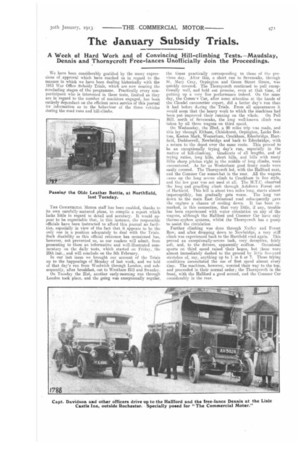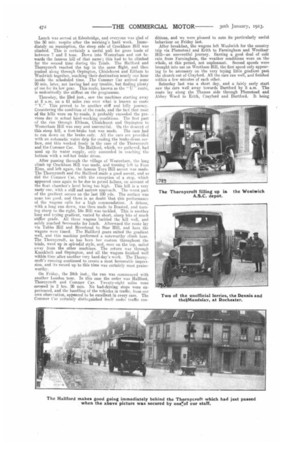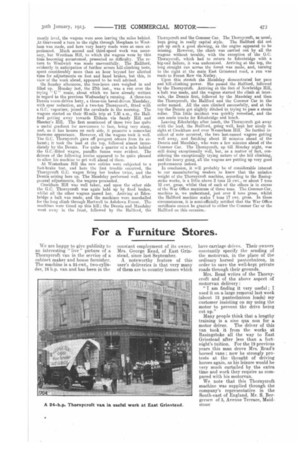The January Subsidy Trials.
Page 11

Page 12

Page 13

If you've noticed an error in this article please click here to report it so we can fix it.
A Week of Hard Work and of Convincing Hill-climbing Tests. —Alaudslay, Dennis and Thornycroft Free-lances Unofficially Join the Proceedings.
We have been considerably gratified by the many expressions of approval which have reached us in regard to the manner in which we have been dealing historically with the 1913 War Office Subsidy Trials, which are now nearing the ;concluding stages of the programme. Practically every nonparticipant who is interested in these tests, limited as they are in regard to the number of machines engaged, has been entirely dependant on the efficient news service of this journal for information as to the behaviour of the three vehicles during the road rims and hill-climbs.
THE COMMERCIAL MOTOR staff has been enabled, thanks to its own carefully-matured plans, to compile a report which lacks little in regard to detail and accuracy. It would appear to be regrettable that, in this instance., the responsible officials have been instructed to afford this journal no facilities, especially in view of the fact that it appears to be the only one in a position adequately to deal with the Trials. Such disability as this official reticence has occasioned has, however, not prevented us, as our readers will admit, from presenting to them an informative and well-illustrated commentary on the daily tests, which started on Friday,. the 10th inst., and will conclude on the 5th February.
In our last issue we brought our account of the Trials up to the happenings of Monday of last week, and we told of that day's run from Woolwich through London, and subsequently, after breakfast, out to Wrotham Hill and Swanky. On Tuesday the 21st, another early-morning run through London took place, and the going was exceptionally regular, the times practically corresponding to those of the peeions day. _A fter this, a short run to Sevenoaks, through St. Mary Cray, Orpington and Green Street Green, was quickly covered. The Thornycroft continued to pull exceptionally well, and held out promise, even at that time, of putting up a very fine performance indeed. On the same day, the Comm-r Car, after some attention at the hands of the Claude' carouretter expert, did a better day's run than it had before during the Trials. From all appearances it would seem that the heavy work to which the machines had been put improved their running on the whole. On Poll Hill, north of Sevenoaks, the long well-known climb was taken by all three wagons on third speed.
On Wednesday, the 22nd, a 90 miles trip was made, and this lay through Eltham, Chislehnrst, Orpington, Locks Bottom, keston Mark, Westerham, Crockham, Edenbridge, Hartfield, Duddeswell, Newbridge and back to Edenbridge, with a return to the depot over the same route. This proved to be an exceptionally trying day's run, especially in the matter of hill-climbing. Gradients of all lengths, and of trying ratios, long hills, short hills, and hills with nasty little sharp pitches right in the middle of long climbs, were encountered. As far as Westerham good frosty roads were easily covered. The Thornycroft led, with the Hanford next, and the Commer Car somewhat in the rear. All the wagons MEM up the long severe climb to Crockham in fine style, and the low gear was not used at all. The observed the long and gruelling climb through _Ashdown Forest out of Flarttield. This hill is about two miles long, starts almost imperceptibly, but gradually gets worse. The long run down to the main East Grinstead road subsequently have the engines a chance of cooling down. It has been remarked, in this connection, that very little, if any, trouble has been experienced with water circulation On any of the wagons, although the Ilallford and Commer Car have only thermo-syphon systems, whilst the Thornycroft has a pinup to assist the circulation
Further climbing was done through Nutley and Forest Row, and after dropping down to Newbridge, a very stiff climb was experienced back to the Hartfield road again. This proved an exceptionally-severe task, very deceptive, fairly soft, and, to the drivers, apparently endless. Occasional spurts on third speed raised their hopes, but these were almost immediately dashed to the ground by little five-yard stretches of, say, anything up to 1 in 6 or 7. These trying conditions necessitated the use of first speed almost every time. The machines, however, worried their way to the top, and proceeded in their normal order ; the Thornycroft in the front, with the Hallford a good second, and the Commer Car considerably in the rear.
Lunch was served at Edenbridge, and everyone was glad of the 50 min. respite after the morning's hard work. .Immediately on resumption, the steep side of Crockham Hill was. climbed. This is certainly a useful pull for gross loads ot between 7 and 8 tons. Down into Westerham and out towards the famous hill of that name; this had to be climbed for the second time during the Trials. The HaIlford and Thernycroft reached the top in the same flight, and then pushed along through Orpington, Chislehnrst and Elthitm to 'Woolwich together, reaching their destination nearly one hour inside the scheduled time. The Commer Car arrived some 20 min. later, not having had any trouble, but finding plenty of use for its low gear. This route, known as the '` U " route, is undoubtedly the stiffest on the programme.
Thursday, the 23rd inst., saw the machines starting away at 8 ant. on a 61 miles run over what is known as route " V." This proved to he another stiff and hilly jonrney. Considering the condition of the roads, and the fact that most of the hills were on by-roads, it probably exceeded the previous day in actual hard-working conditions. The first part of the run through Eitha,m, Cbislehurst and Orpington to Westerham Hill was easy and uneventful. On the descent of this steep hill, a foot-brake test was made. The cars had to run down on the brake only. All the cars are provided with an automatic water drip for cooling the brake-drum sur• face, and this worked freely in the case of the Thornycroft and the Commer Car. The hallford, which, we gatherea, had used up its water supply, only succeeded in reaching the bottom with a red-hot brake drum,
After passing through the village of Westerham, the long climb up Crockhani Hill was made, and turning left to Four Elms, and left a•gain, the famous Toys Hill ascent was made. The Thornycroft and the Hanford made a good ascent, And so did the Commer Car, with the exception of a stop, which appeared once again to be due to petrol failure, on account of the float chamber's level being too high. This hill is a very nasty one, with a stiff and narrow approach. The worst part of the gradient occurs on the last 100 yds. The surface was none too good, and there is no doubt that this performance of the wagons calls for a high commendation. A detour, with a long run down, was then made to Brasted, and turning sharp to the right, Ide Hill was tackled. This is another long and trying gradient, varied by short, sharp bits of much stiffer grade. All three wagons tackled the hill well, and safely -reached Sevenoaks for lunch. Afterward the route lay via Tubbs Hill and Riverhead to Star Hill, and here the wagons were timed. The Hallford gears suited the gradient well, and this machine performed a noteworthy climb here. The Thornycroft, as has been her custom throughout the trials, went up in splendid style, and, once on the top, sailed away from the other machines. The return was through Knockholt and Orpington, and all the wagons finished well within time after another very hard day's work. The Thornycroft's running continued to create a most favourable impression, and its record up to this time was certainly most praiseworthy.
On Friday, the 24th inst the run was commenced with another London tour. In this case the order was Hanford, Thornyeroft and Commer Car. Twenty-eight miles were covered in 2 hrs. 20 min. No bad-driving stops were experienced, and the handling of the vehicles in traffic, frum our own obseivation, appeared to be excellent in every case. The Commer Car certainly distinguished itself uncici traffic con
ditions, and we were pleased to note its particularly useful behaviour on Friday last. After breakfast, the wagons left Woolwich for the country trip via Plumstead and Erith to Farningham and Wrothair Hill—an uneventful journey. Barring a good deal of cold rain from Farningham, the weather conditions were on the • whole, at this period, not unpleasant. Second speeds were brought into use on Wrotham Hill, the first speed only appearing to be necessary on the very trying little gradient past the church out of Crayford. All the cars ran well, and finished within a few minutes of each othei.
Saturday last was a short day, and a, fairly early start saw the cars well away towards Dartford by 8 a.m. The route lay along the Thames side through Flumstead and Abbey Wood to Erith, Crayford and Dartford. It being
mostly level, the wagons were soon leaving the miles behind. At Gravesend a turn to the right through Meopham to Wrotham was made, and here very heavy roads were at once experienced. Much second and third-speed work was necessary, but Wrotham Hill, to which the wagons were by this time becoming accustomed, presented no difficulty. The retern to Woolwich was made uneventfully. The HaIlford, evidently in anticipation of further severe hill-climbing tests, spent considerably more than an hour beyond her allotted time for adjustments on foot and hand brakes, but this, in view of the work ahead, appeared to be well advised.
On Sunday afternoon, the free-lance cars weighed in and filled up. Monday last, the 27th inst., was a run over the trying " Ti" route, about which we have already written in regard to the previous Wednesday's running. A three-ton Dennis worm-driven lorry, a three-ton bevel-driven Matid.slay, with spur reduction, and a two-ton Thornycrort, fitted with a 0.0. vaporizer, joined the cavalcade in the morning. The wagons started on their 90-mile trip at 7.30 a.m., the Hallford getting away towards Eltham via Sandy Hill and Shooter's Hill. The first mentioned of these two has quite a useful gradient for newcomers to face, being very steep, and, as it has houses on each side, it presents a somewhat fearsome appearance. However, all the wagons took it. well. The 0.0. Thornycroft gave off pungent odours from its exhaust; it took the lead at the top, followed almost immediately by the Dennis. For quite a quarter of a mile behind the G.C.-fitted wagon, paraffin fumes were evident. The drivers of the following lorries appeared to be quite pleased to allow his machine to get well ahead of them.
At Westerham Hill the new entries were subjected to a foot-brake test, and here the first trouble occurred, the Thornycroft G.C. wagon firing her brakes twice, and the Dennis seizing hers up. The Maudslay performed well. After general adjustments, the wagons proceeded. Crockham Hill was well taken, and upon the other side the GO, Thornycroft was again held up by fired brakes, whilst all the other wagons passed her. Arriving at Edenbridge a halt was made, and the machines were marshalled for the long climb through Hartwell to Ashdown Forest. The machines were timed up this hill; the Dennis and Maudslay went away in the front, followed by the 1-fallford, the Thornycroft and 'the Commer Car. The Thornycroft, ea usual, kept going in really capital style. The Hallford did not. put up such a good showing, as the engine appeared to be missing. However, the climb was carried out by all the wagons without trouble, with the exception of the G.C. Thornycroft, which had to return to den bridge with a big-cud failure, it was understood. ArrivinK at the top, the long straight run across the forest was mane, and, turning to the right at the main East Grinstead road, a run was made to Forest Row via, Nutley.
Upon this stretch the Maudslay demonstrated her pace and hill-climbing power. She passed the Hanford, followed by the Thornycroft. Arriving at the foot of Newbridge Hill, a halt was made, and the wagons started the climb at intervals, the Dennis first, followed by the Maudslay and then the Thornycroft, the Hallford and the Commer Car in the order named. All the ears climbed successfully, and at the, top the Dennis got slightly ditched in trying to pass a steam roller. This little incident was quickly remedied, and the cars made tracks for Edenbridge and lunch.
Leaving Edenbridge after lunch, the Thornycroft got away with the lead, the Hall ford, going well, kept her nicely ihr sight at Crockham and over AN esterham Hill. No further incident of note occurred, the two last-named wagons getting well away, and finishing about 10 minutes ahead of the Dennis and Maudalay, who were a few minutes ahead of the Commer Car. The 'Thornycroft., up till Monday night, was still doing exceptionally well, but, as a matter of fact, considering the exceptionally trying nature of the hill climbing, and the heavy going, all the wagons are putting up very good performances indeed.
In conclusion, it will probably be of considerable interest to our manufacturing readers to know that the unladen weight of the Thornycroft machine, according to the Basingstoke works, is a little above 2 tons 15 cwt., or about 7 tons 10 cwt, gross, whilst that of each of the others is in excess of the War Office maximum of three tons, The .Commer-Car, machine is, we understand, just over 8 tons gross, whilst the Hallford machine scales 7 tons 17 cwt. gross. In these circumstances, it is semi-officially notified that the War Office certificate cannot be granted to either the Commer Car or the Hanford on this occasion..




























